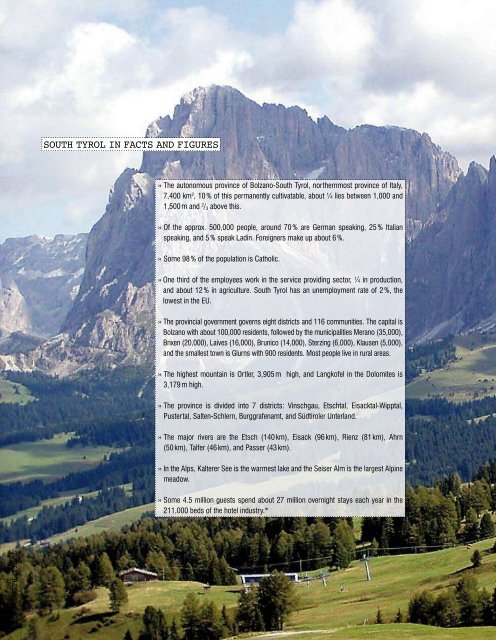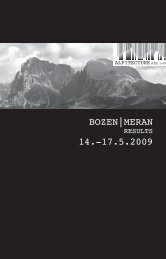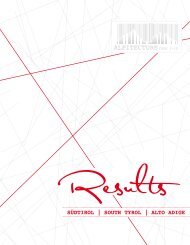Südtirol | South tyrol | Alto Adige - alpitecture
Südtirol | South tyrol | Alto Adige - alpitecture
Südtirol | South tyrol | Alto Adige - alpitecture
You also want an ePaper? Increase the reach of your titles
YUMPU automatically turns print PDFs into web optimized ePapers that Google loves.
souTh Tyrol<br />
6<br />
souTh Tyrol in FAcTs AnD Figures<br />
» The autonomous province of Bolzano-<strong>South</strong> Tyrol, northernmost province of Italy,<br />
7,400 km 2 , 10 % of this permanently cultivatable, about ¼ lies between 1,000 and<br />
1,500 m and 2 /3 above this.<br />
» Of the approx. 500,000 people, around 70 % are German speaking, 25 % Italian<br />
speaking, and 5 % speak Ladin. Foreigners make up about 6 %.<br />
» Some 98 % of the population is Catholic.<br />
» One third of the employees work in the service providing sector, ¼ in production,<br />
and about 12 % in agriculture. <strong>South</strong> Tyrol has an unemployment rate of 2 %, the<br />
lowest in the EU.<br />
» The provincial government governs eight districts and 116 communities. The capital is<br />
Bolzano with about 100,000 residents, followed by the municipalities Merano (35,000),<br />
Brixen (20,000), Laives (16,000), Brunico (14,000), Sterzing (6,000), Klausen (5,000),<br />
and the smallest town is Glurns with 900 residents. Most people live in rural areas.<br />
» The highest mountain is Ortler, 3,905 m high, and Langkofel in the Dolomites is<br />
3,179 m high.<br />
» The province is divided into 7 districts: Vinschgau, Etschtal, Eisacktal-Wipptal,<br />
Pustertal, Salten-Schlern, Burggrafenamt, and <strong>Südtirol</strong>er Unterland.<br />
» The major rivers are the Etsch (140 km), Eisack (96 km), Rienz (81 km), Ahrn<br />
(50 km), Talfer (46 km), and Passer (43 km).<br />
» In the Alps, Kalterer See is the warmest lake and the Seiser Alm is the largest Alpine<br />
meadow.<br />
» Some 4.5 million guests spend about 27 million overnight stays each year in the<br />
211,000 beds of the hotel industry.*<br />
A Few worDs AbouT souTh Tyrol<br />
These statistics do not say much about the fascination of <strong>South</strong> Tyrol. Not about<br />
the stimulating sensation that Goethe felt in 1782 on the Brenner when he reached<br />
Bolzano with the post coach and noted the southern impression in his diary. Sixty<br />
armies of the German emperor passed across the Brenner on their way to Rome for<br />
the coronation by the Pope. This route was secured by numerous castles. Imposing<br />
guest houses arose for the travelling merchants and their goods were traded under<br />
the picturesque arcades in the cities. Craftsmen and artists on their way between<br />
North and <strong>South</strong> left behind samples of their art in the monasteries, churches,<br />
castles, and manors.<br />
<strong>South</strong> <strong>tyrol</strong><br />
For millions of tourists, the <strong>South</strong> begins at the Brenner. On the south side of the Alps, the weather is more<br />
reliable, lovely, mild, and dry. The northernmost vineyards of Italy are located in the valley around Brixen.<br />
This is where the cultivated landscape of <strong>South</strong> Tyrol starts, whose dry stone walls, terraced vineyards,<br />
orchards, fields, meadows, and flood plains are the result of hundreds of years of farmers’ labors. There is<br />
hardly another region that has such a variety of landscapes. When swimming season has begun at Kalterer<br />
See, you can still go skiing in Schnalstal. Those who do not want to climb the pale cliffs of the Dolomites<br />
can hike through the isolated woods of Regglberg or the broad Alpine meadows. Those who want to avoid<br />
the summer heat in Vinschgau can walk along the cooling waterways in Waale. Those who find too much<br />
bustle in the cities can enjoy beautiful days until late fall under the golden foliage in a Buschenschänke, or<br />
country tavern. For culture lovers, there are the many architectural treasures ranging from the Carolingian<br />
period to Gothic, Renaissance, Baroque, and art nouveau. A building tradition marked by stately manors,<br />
grand estates, and richly decorated churches in addition to sturdy guest houses. Austrian and Italian influences<br />
overlap here just as in the food.<br />
The peaceful coexistence of the cultures and languages was disrupted after Italy annexed <strong>South</strong> Tyrol in<br />
1918. Tens of thousands of Italian workers were brought into <strong>South</strong> Tyrol to industrialize Bolzano, the German<br />
language was prohibited, and the German place names were Italianized, often in a random manner.<br />
After the end of World War II, today’s valid, quite extensive autonomy statute for <strong>South</strong> Tyrol was passed in<br />
1972 after difficult negotiations. The enormous economic boom has since then contributed to smoothing<br />
out the ethnic differences and normalizing the way the different ethnic groups interact. Still – kindergartens<br />
and schools are separated linguistically, public positions are given according to ethnical affiliation using<br />
a competition system, and the Italians have been disappointed over the loss of their former privileges.<br />
It will probably take a while before everyone considers themselves as <strong>South</strong> Tyrolean in a region that utilizes<br />
their unique cultural and language variety to the full extent.*<br />
souTh Tyrol<br />
7





